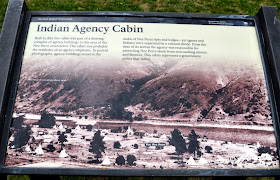After we left Coeur d' Allene, we scampered on down highway 95 south thru the reservation and on past Lewiston, ID. After turning on to highway 12 we came upon the National Historic Park, Nez Perce.
From Wiki: The Nez Perce /ˌnɛzˈpɜrs/ are Native American people who live in the Pacific Northwest region (Columbia River Plateau) of the United States. An anthropological interpretation says they descended from the Old Cordilleran Culture, which moved south from the Rocky Mountains and west in Nez Perce lands.[2] The Nez Perce Nation currently governs and inhabits within the exterior boundaries of the reservation in Idaho. The Nez Perce's name for themselves is Nimíipuu (pronounced [nimiːpuː]), meaning, "The People."
Above, Yellow Wolf...I am reading his narrated biography currently, and his story is fascinating. The book mainly covers his experiences during the wars and in particular the last Indian war, covering well over 1000 miles thru four states ending at Bear Paw near Chinook, MT. Sad reading! Below, Chief Joseph, the leader of the tribe at Bear Paw. He was a warrior & true leader of the nation. He was a compassionate man and father & husband. Bear Paw occurred in 1877, 100 years after we became a country, and it is hard for me to imagine these conflicts were still going on. I recommend reading more about these fantastic true Americans who loved their country and knew how to treat the land & the animals that shared it with them.
Above, a pic of Lewiston, ID from atop the mountain before we drove thru it. Below the visitor center.
Here are a couple of pics of the artifacts on display inside the center.
A nice mural & a ceremonial head dress and arrows.
After viewing the artifacts we took a walk around the former Nez Perce community of Lapwai.
From Wiki:
The area that is today Lapwai was the home of Hin-ma-tute-ke-kaikt, also known as Big Thunder and latter as James. It was hear that Henry H. Spalding established a Protestant mission among the Nez Perce in 1836. This was also the general region that Bill Craig settled since his wife was James' daughter. The city's predecessor, Fort Lapwai, operated on the site from 1863 to 1884. The village of Lapwai was incorporated in 1911, with a model rural school. The word "Lapwai" means place of the butterflies, as the area had thousands in early summer in earlier years.
Here are a few pics of the community just down the hill from the visitor center and situated on the Clearwater River.
The church building is privately owned and is still in use every week.
The headstone for the Spaldings, and the cemetery, still in use.
I could add commentary here, but the story boards I've included here tell just about everything we saw and experienced. Life was hard but very relaxing and rewarding according to the narrative of Yellow Wolf, who liver here in Lapwai for a time during peaceful times.
Below, the remnants of the original mission.
Waited for these two little guys to cross in front of us before continued back up the hill to the center. And below, me looking into the Clearwater River. Later that day, we parked the motor home in a pullout along this river, about 100 miles upstream and slept. Route US12 was very slow. It took another three hours to drive the next 100 miles on this beautiful scenic byway the next day.
This brings us to the end of our visit to the historic site. I am intrigued at the story & plight of our American Natives, and in some cases, can be referred to as our true "forefathers". That of course is just my opinion. Almost all of the Native Americans I've met are humble people who still have fire & compassion. Wish I could spend more time in places such as this to learn more about their histories & heritages. I think they got a raw deal, generally. Guess that's why I do a lot of reading.
So, next blog will be about Grant-Kohrs Ranch in Southern, MT. From Yellowstone NP, RVing Beach Bums.


























No comments:
Post a Comment